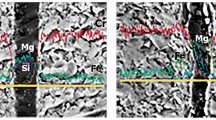Abstract
Sukinda overburden is dumped with chromite ore tailing which contains about 17% Cr2O3. The other constituent with overburden is iron, silica and alumina. Because of its complex nature and large amount of gangue material it is not suitable for the extraction of valuable chromium by conventional route. The author of the present investigation has tried to recover chromium as sodium chromate from chromite overburden. In this investigation the ore is mixed with sodium carbonate. The mixture is heated in a raising hearth furnace at 1123 K. Before roasting, TG/DTA analysis has been done to fix the operating temperature. After roasting at 90 min, the roasted product is ground and sieved. The rate-determining step of roasting for the conversion into sodium chromate has also been investigated and it shows that the required activation energy at the temperature range 923–1123 K is 60 kJ/mole. The roasted product is leached in hot water condition at an optimum pulp density of 1:5 to obtain the chromium recovery. After leaching, solid liquid separation is done. The leach liquor containing sodium chromate is vaporized and a bright yellow crystal of sodium chromate is obtained. A recovery of 85% chromium is obtained at the optimum condition and the purity of sodium chromate is found to be 99.5%. This chromate is suitable for the use in chemical and tanning industries. A portion of ore, roasted product and leached residue are subjected to XRD and EPMA studies to know the mode of conversion and phases present in different stages of reaction.














Similar content being viewed by others
References
A. Das and S. Mishra, Biodegradation of the metallic carcinogen hexavalent chromium Cr (VI) by an indigenously isolated bacterial strain, Journal of Carcinogen, Vol. 9, No. 6, (2010), pp 19-24.
M. Mohanty and H. K. Patra, Attenuation of chromium toxicity in mine waste water hyacinth, Journal of Stress Physiology & Biochemistry, Vol. 17, No. 4, (2011) pp. 336-346.
R. K. Tiwary, R. Dhakate, V. A. Rao and V. S. Singh, Assessment and prediction of contaminant migration in ground water from chromite waste dump, Environmental Geology, Vol. 48, (2005), pp. 420-429.
F. Habashi, Principles of Extractive metallurgy, Gordon and Breach Science Publishers, (1969).
M. P. Antony, V. D. Tathavadkar, C. C. Calvert and A. Jha, The Soda-Ash Roasting of Chromite Ore Processing Residue for the Reclamation of Chromium, Metallurgical and Materials Transaction B, 32B, December 2001, pp.: 987-995.
Fathi Habashi, Handbook of Extractive Metallurgy, Wiley-VCH, Volume IV, 1997, pp.: 1762.
Cuneyt Arslan and Gokhan Orhan, Investigation of chrome (VI) oxide production from chromite concentrate by alkali fusion, Int. J. Miner. Process., 50, 1997(1-2), pp 87-96.
Vilas D. Tathavadkar, M. P. Antony and A. Jha, The Effect of Salt-Phase Composition on the Rate of Soda-Ash Roasting of Chromite Ores, Metallurgical and Materials Transactions B, 34B (2003), p. 555-563.
V.D. Tathavadkar, M.P. Antony and A. Jha, The soda-ash roasting of chromite minerals: Kinetics considerations, Metallurgical and Materials Transactions B, 32B (2001), p. 593.
M.J. Udy, ed. 1956, Vol 1. Chemistry of Chromium and its alloys, Chapman and Hall, New York, NY, (1956).
D. Raghu and H.N. Hsies, Origin, properties and disposal problems of chromium residue, International Journal of Environment studies, 30 (1989), No.3, p. 227.
B. Walawska and Z. Kowalski, Environmental evaluation of the effects of using chromic waste in the production of chromium compounds, Journal of Cleaner Production, 9 (2001), p. 219.
G.L. Hundley, D.H. Nilsen and R.E.Siemens, United states Bureau of Mines Report no. 8977 (1985), Government Printing office, Washington DC.
D. Chandra, G.X. Wang, M.C. Fuerstenan and R.E. Siemens, Alkaline roasting of low grade chromite, Trans of Institution of Mining and Metallurgy, Section C, Mineral Processing & Extractive metallurgy, 105 (1996), p C105.
Acknowledgements
Authors are thankful to Dr Indranil Chattoraj, Director, CSIR- National Metallurgical Laboratory, Jamshedpur, India for providing the necessary facilities to carry out research work. Thanks is also due to him for giving the permission to publish the work.
Author information
Authors and Affiliations
Corresponding author
Additional information
Publisher's Note
Springer Nature remains neutral with regard to jurisdictional claims in published maps and institutional affiliations.
Rights and permissions
About this article
Cite this article
Prasad, S., Kumar, M. & Randhawa, N.S. Processing of Chromite Overburden by Soda Roasting to Recover Chromium as Sodium Chromate. Trans Indian Inst Met 74, 2221–2230 (2021). https://doi.org/10.1007/s12666-021-02320-8
Received:
Accepted:
Published:
Issue Date:
DOI: https://doi.org/10.1007/s12666-021-02320-8




